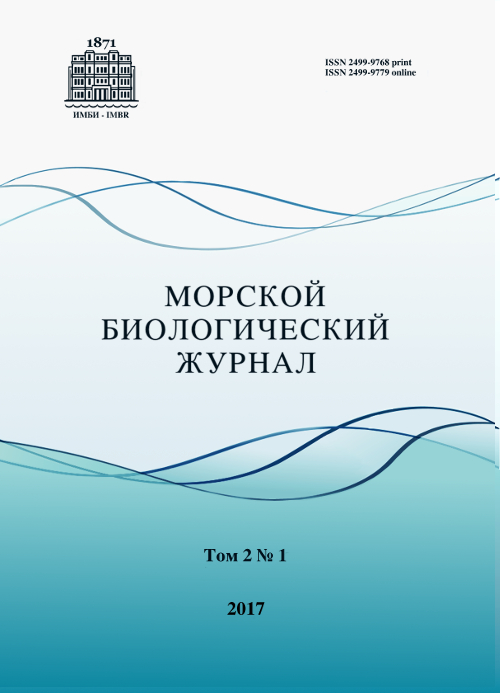Nesting of the little bittern Ixobrychus minutus (Aves: Ardeidae) in an urban area of the Crimean coast of the Black Sea
##plugins.themes.ibsscustom.article.main##
##plugins.themes.ibsscustom.article.details##
Abstract
Observations of the ecological and behavioral adaptations of hydrophilic birds in urban areas are essential for preservation of the biodiversity under extreme anthropogenic transformations of the inland and coastal waters on the Crimean peninsula. In the Crimea a little bittern Ixobrychus minutus (Linnaeus, 1766) nest usually on the fresh and brackish water bodies. For the first time this species was found nesting in Kruglaya bay, the overused recreation area in Sevastopol (Black Sea). Our investigation detected factors determining the breeding efficiency, food spectrum, behavioral responses and the duration of stay of the little bittern in the biotope exposed to high anthropogenic load. Visual observations, photography and video recording were conducted five times a week within Kruglaya bay. Two adult I. minutus were observed from July 3 to August 2, and three immature birds – from July 24 to September 7, 2016 in the bay head. The presence of natural shelter (reed beds) and good feeding base contributed to successful breeding of the birds. The main prey were the juveniles of grey mullet, other preys were peacock blenny Salaria pavo, ocellated wrasse Symphodus ocellatus and invertebrates. The little bitterns showed atypical for this species synanthropic behavior: having gradually adapted to the people neighborhood, they allowed the observer’s presence at 4–6 m distance. In August the young birds began demonstrating territorial behavior and in September they flied beyond the bay area. The study has disclosed high adaptive potential of I. minutus to disturbing factors in atypical to this species habitats in the coastal urban area of the Black Sea. The possibility of little bitterns settling in the fragmentary natural landscape (return urbanization) of urban areas on the Crimean coast of the Black Sea is discussed. Presumably, I. minutus can nest in the semi-aquatic growth bordering some Crimean bays including Kruglaya, Streletskaya, Kazach'ya and Sevastopol bays. The fragments of natural landscape allow preserving the biodiversity; for their protection any building activity ruinous to semi-aquatic vegetation in the coastal zone should be banned.
Authors
References
Алёмов С. В., Витер Т. В. Сообщества макрозообентоса вершины б. Круглая (Севастополь, Чёрное море) // Экологические проблемы Азово-Черноморского региона и комплексное управление прибрежной зоной: материалы молодёж. науч.-практ. конф. (г. Севастополь, 29 сент. – 05 окт. 2014 г.). Севастополь, 2014. С. 176–180. [Alyomov S. V., Viter T. V. Macrozoobentos communities of Kruglaya Bay head (Sevastopol, Black Sea). In: Ecological problems of the Azov-Black sea region and integrated coastal management: materials of youth scientific-practical conference (Sevastopol, 29 Sept.-05 Oct. 2014). Sevastopol, 2014, pp. 176–180. (in Russ.)].
Бескаравайный М. М. Птицы Крымского полуострова. Симферополь : Бизнес-Информ, 2012. 336 с. [Beskaravayny M. M. Ptitsy Krymskogo poluostrova. Simferopol: Biznes-Inform, 2012, 336 p. (in Russ.)].
Болтачёв А. Р., Карпова Е. П. Ихтиофауна прибрежной зоны Севастополя (Чёрное море) // Морской экологический журнал. 2012. Т. 11, № 2. С. 10–27. [Boltachev A. R., Karpova E. P. The ichthyofauna of the Sevastopol coastal zone (the Black Sea) // Morskoj ekologicheskij zhurnal, 2012, vol. 11, no. 2, pp. 10–27. (in Russ.)].
Гирагосов В. Е., Бескаравайный М. М. Сезонная динамика гидрофильного орнитокомплекса бухты Круглая (Севастополь) // Морской биологический журнал. 2016. Т. 1, № 4. С. 12–21. [Giragosov V. E., Beskaravayny M. M. Seasonal dynamics of the hydrophilic bird community of Kruglaya Bay (Sevastopol). Morskoj biologicheskij zhurnal, 2016, vol. 1, no. 4, p. 12–21. (in Russ.)].
Костин С. Ю., Тарина Н. А. Распределение и биология размножения веслоногих и голенастых птиц на Лебяжьих островах и определьных территориях // Бранта: сборник научных трудов Азово-Черноморской орнитологической станции. 2004. Вып. 7. С. 82–111. [Kostin S. Yu., Tarina N. A. Distribution and biology of Pelecaniformes and Ciconiiformes on the Lebyazhy Islands and surrounding area Branta: Sbornik nauchnykh trudov AzovoChernomorskoi ornitologicheskoi stantsii, 2004, iss. 7, pp. 82–111. (in Russ.)]
Костин Ю. В. Птицы Крыма. Москва: Наука, 1983. 249 c. [Kostin Yu. V. Ptitsy Kryma. Moscow: Nauka, 1983, 249 p. (in Russ.)].
Кучеренко В. Н., Баник М. В., Атемасов А. А., Вергелес Ю. И. Сообщества гнездящихся птиц пресных и слабосолёных водоёмов Западного Крыма // Бранта: сборник научных трудов Азово-Черноморской орнитологической станции. 2015. Вып. 18. С. 75–89. [Kucherenko V. N., Banik M. V., Atemasov A. A., Vergeles Yu. I. The communities of breeding birds of freshwater and slightly brackish lakes of the Western Crimea Branta: Sbornik nauchnykh trudov Azovo-Chernomorskoi ornitologicheskoi stantsii, 2015, iss. 18, pp. 75–89. (in Russ.)].
Приклонский С. Г., Дмитренок М. Г., Зубакин В. А., Мищенко А. Л. Волчок Ixobrychus minutus (Linnaeus, 1766) // Птицы России и сопредельных регионов: Пеликанообразные, Аистообразные, Фламингообразные. Москва: Товарищество научных изданий КМК, 2011. С. 177–189. [Priklonskii S. G., Dmitrenok M. G., Zubakin V. A., Mishchenko A. L. Volchok Ixobrychus minutus (Linnaeus, 1766) // Ptitsy Rossii i sopredel’nykh regionov: Pelikanoobraznye, Aistoobraznye, Flamingoobraznye. Moscow: Tovarishchestvo nauchnykh izdanii KMK, 2011, pp. 177–189. (in Russ.)].
Фридман В. С., Ерёмкин Г. С., Захарова Н. Ю. Возвратная урбанизация –– последний шанс на спасение уязвимых видов птиц Европы? [Электронный ресурс] // Russian Journal of Ecosystem Ecology, 2016, vol. 1, no. 4. Режим доступа: http://rjee.ru/rjee_1_4_2016_3/, doi 10.21685/2500-0578-2016-4-3 [Дата обращения: 25.02.2017]. [Friedmann V. S., Eryomkin G. S., Zakharova N. Yu. Return urbanization – the last chance for endangered species of birds in Europe and others highurbanised regions, or is it? [Electronic resource] // Russian Journal of Ecosystem Ecology, 2016, vol. 1, no. 4. Available at: http://rjee.ru/rjee_1_4_2016_3/, doi 10.21685/2500-0578-2016-4-3, [accessed 25.02.2017] (in Russ.)].


 Google Scholar
Google Scholar



